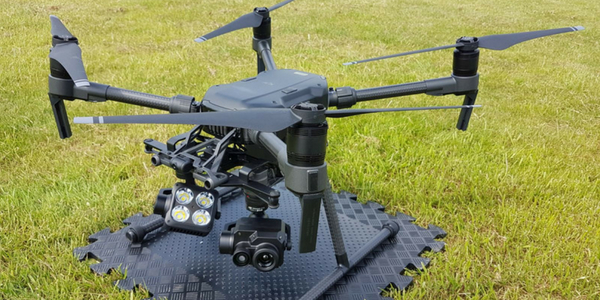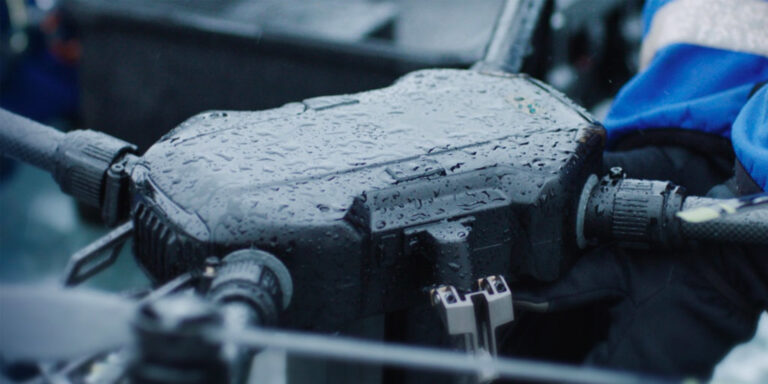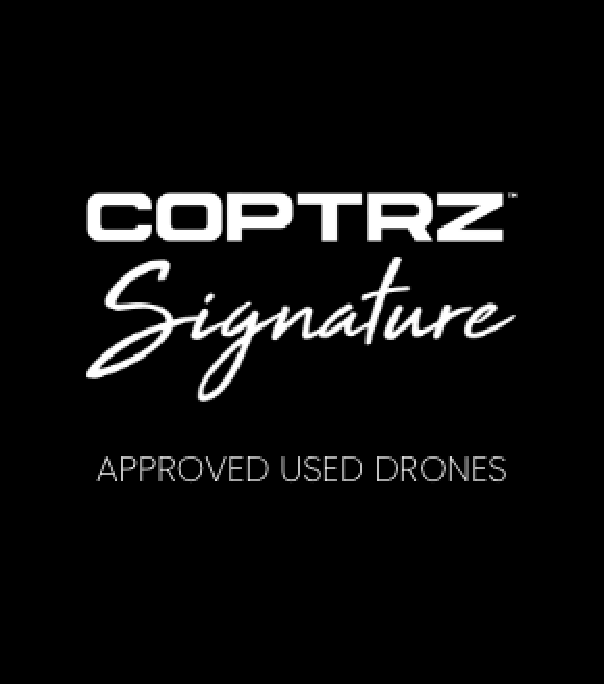With the launch of the Mavic 2 Enterprise Dual, DJI essentially offered up a one-stop solution for those looking to take the first step into the many areas of aerial thermography systems – whether that’s for inspections, search and rescue, site management, energy, agriculture or anything else where detecting even subtle changes in temperature can make a huge difference. However, that does beg the question of where it’s much-lauded Zenmuse XT2 thermal imaging camera, launched back in March 2018, now lies within its fleet.
The most obvious difference is that the M2ED is a fixed solution, coming fitted to what is basically the core Mavic 2 unit, whereas the XT2 camera can be equipped to any of the M200 Series models, as well as the M600 Pro (though a couple of intelligent flight features won’t work on this model). On the one hand, you’ve got the small and compact M2ED which only supports the one camera/gimbal (bearing in mind it’s a dual camera with visual as well as thermal capabilities); on the other you’ve got the option for these much larger rigs that can carry multiple payloads, additional onboard computers and more. The M210, for example, can equip two separate gimbals, enabling you to run an XT2 alongside something like the Z30 zoom camera.

In many other ways, the differences can be seen as negligible, with flight times swaying around the 30-minute mark across all models and the camera quality and general functionality frequently similar. Perhaps the most notable difference in quality is that the M2ED comes packed into FLIR’s smallest thermal micro-camera to date, which comes at the cost of a reduced thermal resolution – the FLIR Lepton on the M2ED offers up to 160 x 120, whereas the XT2 goes up to 640 x 512. This means that you’re getting 3x the thermal image quality from the XT2, this level of accuracy can be crucial where the most detailed data is required.
Simple or Serious?
Of course, this doesn’t mean that the M2ED has a poor quality camera – far from it. Besides the thermal resolution, the other differences are pretty much nominal (the visual photography and video specs are much the same). And the fact that the drone itself is a newer model and therefore comes with the numerous updates in terms of flight features, processing power and obstacle avoidance that DJI has implemented in the past year, could be seen as a greater benefit.
There’s also no need for any of the effort involved in setting up an XT2 and it folds down into something you can slip into a backpack with ease. In terms of simplicity and convenience, the M2ED has a lot going for it. The modular design of the craft means that you can add the likes of the Spotlight, Beacon or Speaker components (plus whatever else DJI or other third-parties come up with in the months ahead), so you do have some flexibility.

If you want something a little more serious, and more flexible in its fine-tuning and possible customisation for a more specific solution, then equipping the likes of an M200 with the XT2 thermal camera is an ideal combination. The FLIR Tau 2 sensor on the XT2 offers a better thermal resolution, and you also get all of the bells and whistles in terms of real-time analysis of data (although both models give impressive overlays comparing and combining thermal and RPG images),image optimisation, digital zoom and greater control over the information you see and collate.
Obviously if you don’t already own an M200, M210 or M600 Pro, then that does become a more costly issue, but the drones themselves are equipped to handle just about anything you can throw at them in terms of payloads or solutions, and come with added safety and redundancy features for operating in inclement weather or various professional environments. If flexibility and adaptability are paramount, or just that you need the very best thermal images to give you that most accurate of results, then a drone with an XT2 camera equipped has to be considered.
The Same, But Different…
You could compare the M2ED with the likes of an XT2-equipped M200 as being two sides of the same coin, in that both could be maximised in the same situation in slightly different ways. For example, in a fire-fighting scenario, the better thermal resolution of the XT2 could be used to send the M200 up to a greater height, offering a wider overview of the scene without losing that degree of detail that the M2ED would lose once you get up to around 100-150ft.

However, while that M200 is being prepped and calibrated, someone could have the M2ED up and flying, using its smaller frame to swoop around the buildings and give a closer look into the windows and doorways that could help to identify people trapped inside, or safe routes through the fire and smoke on a lower level, where the lesser thermal resolution isn’t really an issue.
Much like an aerial photographer might use an Inspire 2 for some work and a DJI Spark for other jobs, it’s about balancing that demand for the highest quality against the speed and simplicity of something that will still deliver very impressive results. Ultimately it comes down to what you’ll be using the system for and what kind of data you’re looking for. If you’re just looking to get a feel for aerial thermography, then the M2ED has everything you need to get you started, but if you’re looking for something a little more bespoke or top-of-the-line, then an XT2 solution is well worth a look. Either way, you’ll be getting an entirely new perspective on the world.
Features Comparison
Visual Camera
| Mavic 2 Enterprise | Zenmuse XT2 | |
| Sensor | 1/2.3″ CMOS; Effective pixels: 12M | 1/1.7″ CMOS Effective Pixels: 12M |
| Prime Lens | FOV: approx. 85° 35 mm format equivalent:24 mm Aperture: f/2.8 Focus: 0.5 m to ∞ | Prime lens Focus at 8 mm FOV 57.12°× 42.44° |
| Focal length | 24mm 48mm | 9mm 13mm 19mm 25mm |
| Max Video Bitrate | 100 Mbps | 100 Mbps |
| Photo | JPEG | JPEG, TIFF, R-JPEG |
| Anti-flicker | Auto, 50 Hz, 60 Hz | Auto, 50 Hz, 60 Hz |
| Still Photography Modes | Single shot Burst shooting: 3/5/7 frames | Single Shot Burst Shooting: 3/5 frames (2/3/4/7/10/15/20/30 sec) |
| Video Recording Modes | 4K Ultra HD:3840×2160 30p 2.7K:2688×1512 30p FHD:1920×1080 30p | 4K Ultra HD: 3840×2160 30p 2.7K:2688×1512 30p |
| Video Format | MP4,MOV (MPEG-4 AVC/H.264) | MP4,MOV (MPEG-4 AVC/H.264) |
| Video Caption | Supported | Supported |
| Storage | 24Gb onboard storage MicroSD card | MicroSD card Max capacity: 128 GB |
Thermal Camera
| Mavic 2 Enterprise | Zenmuse XT2 | |
| Thermal Camera | FLIR Lepton thermal microcamera | FLIR Tau 2 thermal |
| Thermal Sensor | Uncooled VOx Microbolometer | Uncooled VOx Microbolometer |
| Lens Options | Single lens: HFOV: 57° Aperture: f/1.1 | 9mm, 13mm, 19mm, 25mm |
| Pixel Pitch | 12 μm | 17 μm |
| Spectral Band | 8-14 μm | 7.5-13.5 μm |
| Video Format | MP4, MOV MPEG-4 AVC/H.264 | 8 bit: MOV, MP4 14 bit: TIFF Sequence, SEQ |
| Photo | JPEG | JPEG, TIFF, R-JPEG |
| Still Photography Modes | Single shot Burst shooting: 3/5/7 frames | Single shot Burst shooting: 2/3/4/7/10/ 15/20/30 frames |
Image processing
| Mavic 2 Enterprise | Zenmuse XT2 | |
| Image optimisation | No | Yes |
| Digital detail enhancement | No | Yes |
| Polarity control (black hot/white hot) | No | Yes |
| Colour & Monochrome palettes (LUTs) | No | Yes |
Find out more about the Mavic 2 Enterprise Dual
Find out more about our M210 Thermal Drone Inspection package

